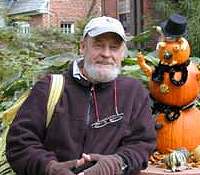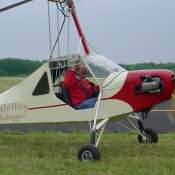...and back!
by Ron Herron.
 Andy Keech of Frederick, Maryland recently achieved what few gyro pilots have ever done. A transcontinental flight across the United States from Frederick, Md, to San Diego, Ca. And then he turned around and flew back!
Andy Keech of Frederick, Maryland recently achieved what few gyro pilots have ever done. A transcontinental flight across the United States from Frederick, Md, to San Diego, Ca. And then he turned around and flew back!
The aircraft flown was a Little Wing LW-5 autogyro. It is the two-seat tandem short-frame tractor gyro, powered by a Rotax 914 Turbo. It was inspected and weighed (as was Andy) at the start and again in San Diego. The aircraft lost 2 pounds and Andy lost 10! The flight back was even more impressive as he didn't encounter any weather difficulties...at least not enough to stop him, and he continued without interruption. He made it from San Diego to Kitty Hawk in under 5 days!
This wasn't Andy's first long-distance flight though. After the construction of his aircraft, he flew 40 hours around North Little Rock, then to the P.R.A. International Fly-In at Waxahatchie Texas, then from there to his home in Frederick, Maryland. He has flown several cross-country flights in the eastern USA, including a flight totalling 4.3 hours without landing.
It's not that a transcontinental flight in a gyro hadn't been done before. John Miller did it in a fully certified, factory-built Pitcairn PCA-2 in 1931. Andy's flight was quicker but John Miller set a high standard for Andy and others to aspire to. Amelia Earhart did it over a period of many weeks but crashed three times, once totalling the aircraft. She was fully sponsored and followed with a support plane and ground support.
Ken Brock did it in short hops (one-way only) in a Bensen (KB-2) but had a ground crew that sometimes beat him to the next fuel stop. Howard Merkel did it (one way only) in a Continental-powered Barnett. His flight included several complications but was basically, a good flight. The aircraft was trailered back home.
A couple of sponsored RAF's made their way across the country but never made it back to their goal site of Oshkosh. They had several breakdowns and at least one crash.
Andy's flight included an additional 450 miles to and from the official start site (Kitty Hawk) from his home base in Fredrick, Maryland. Then, 3-5 hour flights between fuel stops averaging over 90 mph for the trip and he had absolutely no ground or air support. He carried nothing but a backpack. It was all funded straight out of his pocket. He made his way to and from the two oceans without any mishap or major difficulty. This is what made his flight significant.
He has earned my sincere admiration. He will hopefully write a detailed story of the flight. He has already told me many interesting, once-in-a-lifetime, stories of the journey. I can't wait to hear them all.
Stay tuned. Ron.

Andy and his wife Marie. This photo
was taken just after he landed in Fredrick.
